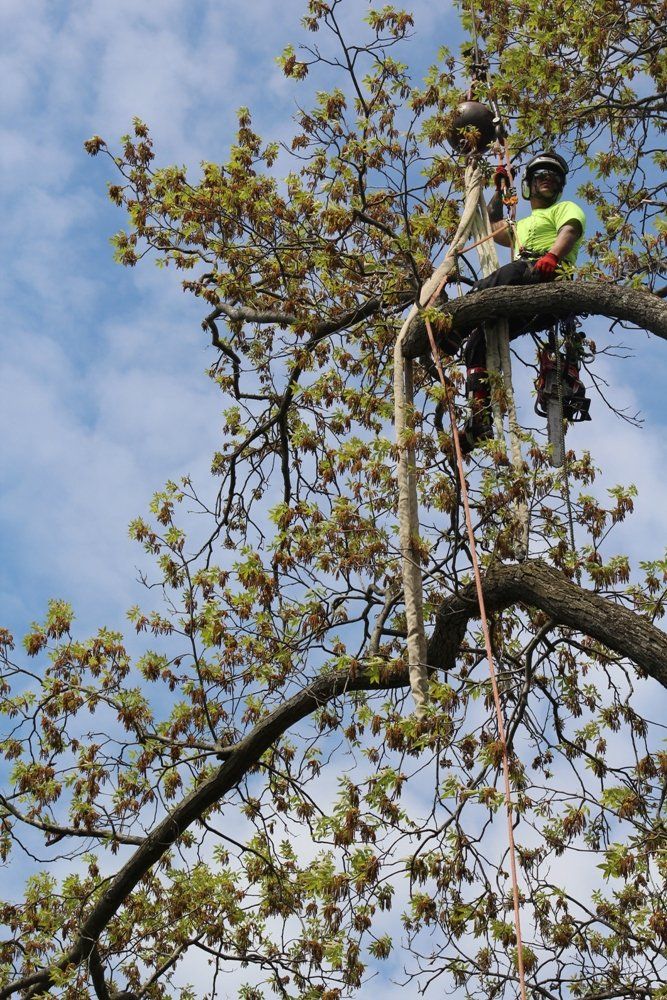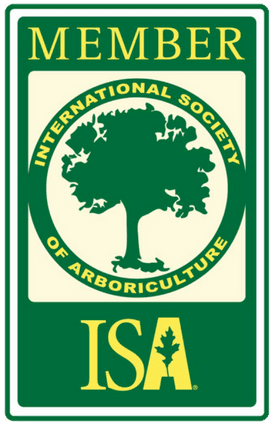Plant Health Care Services for South Eastern PA and Central NJ
At Alpine Tree Specialists, we understand the importance of maintaining the health and vitality of your trees and shrubs. Our Plant Health Care (PHC) services are designed to address the unique challenges presented by Pennsylvania and New Jersey's diverse climates and environments.
By taking a proactive approach to tree and plant care, we help homeowners and businesses protect their landscapes from pests, diseases, and environmental stressors.
What is Tree Health Care?
Tree health care is a holistic approach to tree care that focuses on developing and maintaining healthy plants, trees, and shrubs, making them less susceptible to problems. Regular care can help prevent issues before they arise, and proactive tree care is often more cost-effective than reactively treating advanced problems or removing large trees later.
At its core, plant health care involves regular monitoring, early detection of issues, and timely interventions. Addressing potential problems early ensures the long-term health and vitality of your landscape's trees and shrubs. This approach not only enhances the beauty of your landscape but also contributes to the overall health of the environment.
Common Tree Health Issues in Pennsylvania and New Jersey
The diverse climate of Pennsylvania and New Jersey creates ideal conditions for various plant health challenges.
Below, we outline some of the most common issues we address:

1. Emerald Ash Borer and Ash Tree Health
Emerald Ash Borer (EAB): This destructive invasive pest typically targets ash trees, causing symptoms in EAB-infested ash trees such as canopy thinning, bark splitting, and eventual tree death. Since EAB has been prevalent in Pennsylvania since 2007 it’s highly likely your tree is already infected, especially if it’s located in an urban environment. Our tree professionals are trained to inspect and treat your trees if they see signs of EAB.
Ash Tree Decline: In addition to EAB, ash trees can suffer significantly from environmental stress, soil compaction, and fungal infections that weaken their overall health.
2. Tree Diseases
Anthracnose: This fungal disease affects many deciduous trees, including sycamore, oak, and maple. Symptoms include leaf spots, curling, and premature leaf drop.
Apple Scab: Common in crabapple trees, this disease causes unsightly lesions on leaves and fruit, leading to early defoliation.
Cedar-Apple Rust: This disease alternates between junipers and apple trees, causing galls on junipers and yellow-orange spots on apple leaves.
Phytophthora Root Rot: Phytophthora root rot, caused by water-loving Phytophthora fungi, attacks tree roots in wet soils, leading to wilting, yellowing leaves, and eventual dieback, and it’s a sneaky killer in poorly drained areas.
Verticillium Wilt: A soil-borne fungal disease that affects a wide range of trees and shrubs, causing branch dieback and leaf discoloration.
3. Tree Pests
Spotted Lanternfly: A significant threat to hardwood trees, fruit crops, and ornamental plants. These insects feed on sap, weakening plants and leaving behind a sticky residue.
Bagworms: These pests create bag-like cocoons and can defoliate trees, particularly evergreens like arborvitae and spruce.
Gypsy Moths (Lymantria dispar): Known for their voracious appetite, gypsy moth caterpillars can defoliate entire trees, weakening them over time.
Scale Insects: Affecting a variety of trees and shrubs, scale insects feed on sap and excrete honeydew, which promotes sooty mold growth.
4. Environmental Stresses
Drought Stress: Prolonged periods without rain can weaken trees, making them more susceptible to pests and diseases.
Soil Compaction: Common in urban and suburban areas, compacted soil restricts root growth and reduces oxygen availability.
Nutrient Deficiencies: Poor soil quality or imbalanced pH levels can prevent trees and plants from absorbing essential nutrients.
Storm Damage: Severe weather, including high winds, heavy snow, and ice, can weaken trees and make them susceptible to infections and infestations
Signs and Symptoms of Pest Infestation
Signs and symptoms of pest infestation on trees vary by pest but most share some of these common red flags:
- Leaf Damage: Chewed, skeletonized, or yellowing leaves signal trouble—think caterpillars, beetles, or aphids sucking sap. Wilting or curling leaves might mean root disease like Phytophthora root rot or borers disrupting water flow.
- Bark Issues: Peeling, cracking, or discolored bark often points to borers (e.g., EAB’s D-shaped exit holes) or fungal entry after pest damage. Sawdust-like frass near holes screams wood-boring insects.
- Canopy Dieback: Thinning or dead branches at the top suggest pests like EAB, bark beetles, or root rot fungi choking the tree’s lifeline. Early dieback can also be a sign of drought stress, so look closely.
- Holes and Tunnels: Tiny exit holes (EAB’s D-shape, bark beetles’ pinpricks) or galleries under bark mean larvae are chewing inside. Root pests might not show this—look for soggy, dark roots instead.
- Pest Presence: Spot the culprits—ants trailing aphids, beetles on bark, or wasps circling (could be parasites hunting pests). Eggs or larvae under leaves or in crevices confirm it.
- Woodpecker Activity: Heavy pecking means they’re after grubs—EAB or other borers are likely suspects.
- Stunted Growth: Slow growth, small leaves, or sparse budding can tie to root pests (Phytophthora, nematodes) or sap-feeders draining energy. It could also mean the tree is not getting the nutrients it needs to thrive.
- Fungal Signs: Oozing sap, mushrooms at the base, or funky mats under bark often follow pest wounds—Phytophthora or secondary fungi love stressed trees.
By being aware of the signs and symptoms of pest invasion and taking proactive steps to prevent problems, you can help keep your trees healthy and thriving. If you suspect an Emerald Ash Borer or other pest problems, consult with a certified arborist or tree care professional at Alpine Tree Specialists for guidance on the best course of action.
Our Comprehensive Tree Health Care Program
At Alpine Tree Specialists, our program is designed to provide holistic care for your property. Here are the key components of our services:
1. Tree and Shrub Inspections
Regular inspections by our certified arborists are crucial for identifying early signs of trouble. During these assessments, we look for:
- Stressed trees and shrubs that could become pest targets
- Soil issues such as compacted soil or inadequate drainage
- Cultural issues such as improper watering or improper planting (Ex: Mulch Volcanos)
- Fungal growth and cankers
- Insect infestations
- Leaf discoloration or premature shedding
- Structural issues, such as cracks or weak branches
2. Pest and Disease Management
We use targeted treatments to manage pests and diseases effectively:
- Integrated Pest Management (IPM): A sustainable approach that combines biological, cultural, and chemical controls.
- Soil Care: Our tree experts will guide you in preventing stress that makes your trees or shrubs vulnerable to pests and diseases, offering a tailored soil care program and teaching you simple, hands-on practices—like proper watering—to maintain their health on your own.
- Fungicide Applications: To protect trees from fungal infections like anthracnose and apple scab.
- Insecticide Treatments: For controlling invasive pests such as EAB and spotted lanternflies. We emphasize the importance of selecting responsible and effective insecticide treatments.
3. Soil Care and Fertilization
Healthy soil is the foundation of a thriving landscape. Our services include:
- Soil Testing: We analyze your soil’s pH levels, nutrient content, and compaction to pinpoint exactly what your landscape needs to thrive.
- Soil Amendments: We enhance tree and shrub resilience by delivering essential nutrients through deep root fertilization tailored to your soil’s deficiencies.
- Watering: We provide targeted watering solutions for trees and shrubs to combat drought stress and alleviate soil compaction effectively.
- Mulching: We apply mulch to retain moisture, regulate soil temperature, and suppress weed growth, giving your landscape a healthy edge.
4. Ash Tree Preservation
Preserving ash trees in the face of threats like the Emerald Ash Borer is a top priority for Alpine Tree Specialists. Our services include:
- Preventative insecticide treatments to protect healthy ash trees.
- Remedial treatments for infested trees to slow the progression of damage.
- Proper management of infested wood to prevent the spread of EAB, including guidance on local disposal regulations and best practices following tree removal.
- Monitoring programs to ensure early detection of EAB activity.
Why Choose Alpine Tree Specialists?
When it comes to plant health care in Pennsylvania and New Jersey, Alpine Tree Specialists stands out for our expertise, dedication, and customer-focused approach:
- Certified Arborists: Our ISA-certified arborists specialize in diagnosing and treating the unique tree health issues found in Pennsylvania and New Jersey.
- Customized Solutions: We tailor our services to meet the specific needs of your land.
- Eco-Friendly Practices: We prioritize sustainable methods to protect the environment while maintaining plant health.
- Emergency Services: We’re available 24/7 to address urgent tree care issues, such as storm damage or pest outbreaks.
- Comprehensive Care: From diagnosis to treatment and ongoing maintenance, we provide end-to-end solutions for your plant health care needs.
Schedule a Plant Health Care Consultation Today
Protecting your trees is an investment in the beauty and value of your property or yard. Whether you’re dealing with an existing issue or want to take a proactive approach to plant health, Alpine Tree Specialists is here to help.
Contact Alpine Tree Specialists today for a consultation and discover how our Plant Health Care services can protect your landscape in Pennsylvania and New Jersey. Together, we can determine the service your property needs and help ensure the long-term health and vitality of your landscape.


